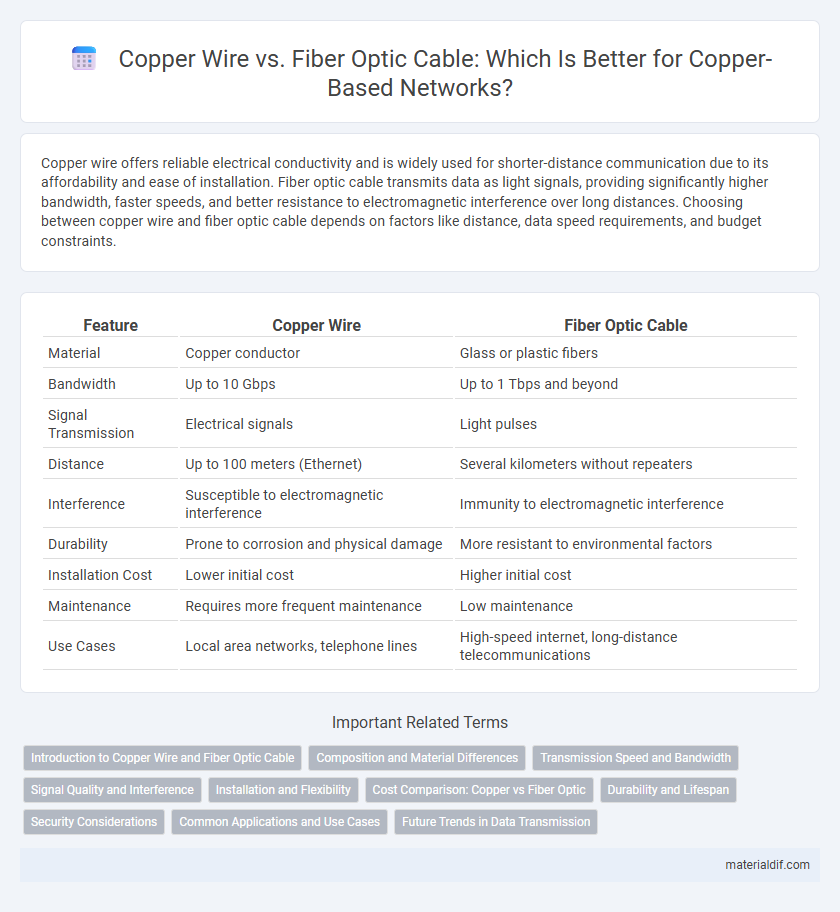Copper wire offers reliable electrical conductivity and is widely used for shorter-distance communication due to its affordability and ease of installation. Fiber optic cable transmits data as light signals, providing significantly higher bandwidth, faster speeds, and better resistance to electromagnetic interference over long distances. Choosing between copper wire and fiber optic cable depends on factors like distance, data speed requirements, and budget constraints.
Table of Comparison
| Feature | Copper Wire | Fiber Optic Cable |
|---|---|---|
| Material | Copper conductor | Glass or plastic fibers |
| Bandwidth | Up to 10 Gbps | Up to 1 Tbps and beyond |
| Signal Transmission | Electrical signals | Light pulses |
| Distance | Up to 100 meters (Ethernet) | Several kilometers without repeaters |
| Interference | Susceptible to electromagnetic interference | Immunity to electromagnetic interference |
| Durability | Prone to corrosion and physical damage | More resistant to environmental factors |
| Installation Cost | Lower initial cost | Higher initial cost |
| Maintenance | Requires more frequent maintenance | Low maintenance |
| Use Cases | Local area networks, telephone lines | High-speed internet, long-distance telecommunications |
Introduction to Copper Wire and Fiber Optic Cable
Copper wire, composed of conductive copper strands, has been a fundamental medium for electrical transmission and telecommunications due to its excellent conductivity and durability. Fiber optic cable, consisting of thin strands of glass or plastic fibers, transmits data as pulses of light, offering significantly higher bandwidth and resistance to electromagnetic interference. Both copper wire and fiber optic cable serve critical roles in communication infrastructure, with copper excelling in short-distance applications and fiber optic cables dominating long-distance, high-speed data transmission.
Composition and Material Differences
Copper wire consists primarily of pure copper, known for its excellent electrical conductivity and flexibility, commonly insulated with plastic or rubber materials. Fiber optic cable uses strands of glass or plastic fibers to transmit data as light signals, enclosed in protective layers including cladding, buffers, and outer jackets made from durable polymers. The fundamental difference lies in copper's metal composition enabling electrical signal transmission versus the glass-based composition of fiber optics facilitating high-speed optical communication.
Transmission Speed and Bandwidth
Copper wire typically supports transmission speeds up to 10 Gbps with bandwidth limitations due to signal degradation over long distances. Fiber optic cables offer significantly higher transmission speeds, reaching terabits per second, and provide greater bandwidth capacity with minimal signal loss over extended ranges. This makes fiber optics the preferred choice for high-speed, high-bandwidth data transmission in modern communication networks.
Signal Quality and Interference
Copper wire transmits signals through electrical impulses, making it susceptible to electromagnetic interference (EMI) and signal degradation over long distances, which impacts overall signal quality. Fiber optic cable uses light to transmit data, offering significantly higher resistance to electromagnetic interference and maintaining consistent signal integrity over extended lengths. This makes fiber optic cables the preferred choice for applications requiring high bandwidth and minimal signal loss.
Installation and Flexibility
Copper wire installation is generally easier and less expensive due to its flexibility and compatibility with existing infrastructure, making it ideal for short-distance and simpler network setups. Fiber optic cable installation requires specialized tools and skilled technicians because of its fragile glass fibers, but it offers superior flexibility in high-density environments and longer-distance applications. The durability and smaller diameter of fiber optic cables also enable easier routing through tight spaces compared to the thicker, less flexible copper wires.
Cost Comparison: Copper vs Fiber Optic
Copper wire generally costs less upfront than fiber optic cable, making it an attractive option for shorter distance applications. Fiber optic cable incurs higher initial costs due to materials and installation complexity but offers lower maintenance expenses and greater bandwidth capacity over time. The total cost of ownership favors fiber optic for long-term, high-performance network infrastructure despite its higher initial investment.
Durability and Lifespan
Copper wire exhibits excellent durability with resistance to physical stress and environmental factors, often lasting 20 to 40 years under optimal conditions. Fiber optic cable offers superior lifespan, exceeding 40 years due to its immunity to electromagnetic interference, corrosion, and signal degradation. Despite copper's robustness, fiber optic cables provide enhanced long-term reliability for data transmission infrastructure.
Security Considerations
Copper wire transmits electrical signals that can be intercepted through electromagnetic interference or physical tapping, posing higher risks for data breaches. Fiber optic cable uses light to transmit data, making it inherently immune to electromagnetic interference and extremely difficult to tap without detection, enhancing data security. Fiber optics are preferable in environments requiring high levels of confidentiality and protection against cyber threats.
Common Applications and Use Cases
Copper wire is extensively used for electrical wiring in residential and commercial buildings, telecommunications, and power transmission due to its excellent conductivity and flexibility. Fiber optic cable, favored in high-speed internet, data centers, and long-distance telecommunications, offers superior bandwidth and resistance to electromagnetic interference. Both materials serve critical roles in network infrastructure, with copper supporting shorter distances and analog signals, while fiber optics excel in high-capacity, digital data transmission over vast distances.
Future Trends in Data Transmission
Copper wire remains widely used for data transmission due to its established infrastructure and cost-effectiveness, but fiber optic cable is increasingly preferred for future trends because of its superior bandwidth capacity and lower signal attenuation over long distances. Emerging technologies like 5G and IoT demand higher data rates and more reliable connections, driving a shift toward fiber optic networks that can support multi-gigabit speeds and enhanced scalability. Investment in fiber-to-the-home (FTTH) and advanced optical components highlights the ongoing transition favoring fiber optics for next-generation communication systems.
Copper Wire vs Fiber Optic Cable Infographic

 materialdif.com
materialdif.com